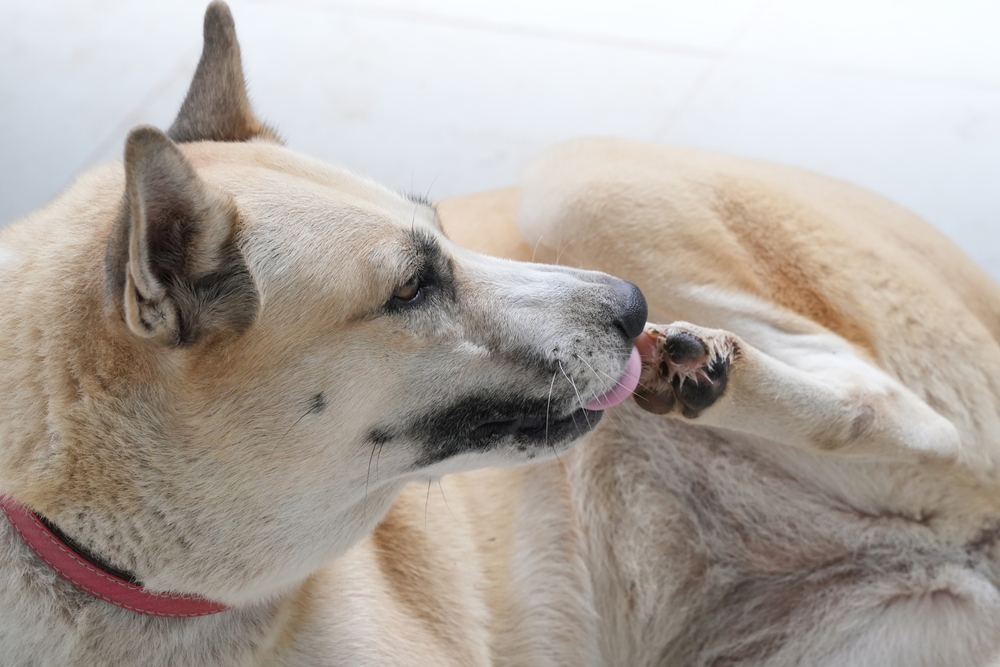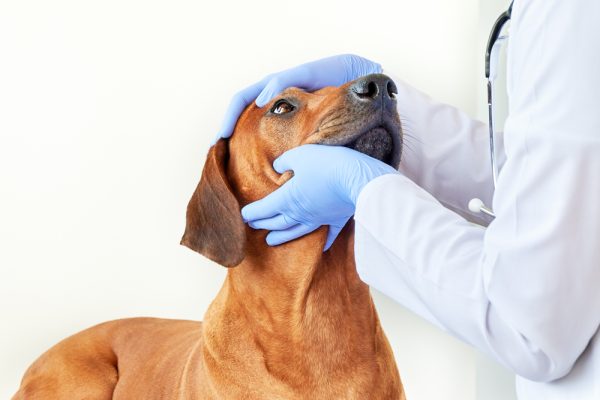In this article
A dog’s paws are more sensitive than you’d think, yet sturdy enough to handle running around on all sorts of surfaces all day long. If you’ve noticed your dog’s paws are pink and black all of a sudden for seemingly no reason, there could be a number of possible culprits. To determine which is the cause and whether you should be alarmed, let’s explore some reasons your dog’s paws could suffer discoloration.

The 7 Possible Reasons Why Dog Paws Are Pink and Black
1. It’s Normal (For Some Breeds)
Some dog breeds or individual dogs can have pink and black paws naturally. Usually, their coats will be light-colored. This creates a distinctly marbled look mixing black and pink. That means your dog’s paws are perfectly fine and you don’t have anything to worry about, but feel free to keep reading below if that’s not the case for your dog. Some dogs may only have these patchy-looking paws when they are young, while others keep the coloring their entire life.
2. Old Skin Is Peeling
Particularly rough-and-tumble dogs that do a lot of running on hard surfaces can wear out the skin on their paw pads, causing a degree of discoloration. In bad cases, your dog’s paw pads may be cracked, bleeding, or more worn in some spots than others. Very mild peeling usually isn’t serious, and the best you can do for your dog is to keep their paws clean and to limit them from walking on hard surfaces. However, if the paw pads are cracked, bleeding, or swollen, or if your dog seems uncomfortable or licks their paws, you should seek veterinary help.

3. They’re Growing Up
Dogs have very soft, squishy, pink, or sometimes blackish pads when they’re born, but those soft paws gradually thicken and eventually wear away as your puppy grows into adulthood. This can give a marbled look to your dog’s pads, but as long as they’re not cracked or bleeding, they’re fine as long as they’re not in any pain. However, a young puppy’s growing pads are very sensitive to environmental hazards like rocks or hot surfaces, and you’ll want to watch where they play for the time being.
4. They Have an Allergy
Black or pink paws on dogs can sometimes be caused by skin allergies, which are quite common. They can be triggered by food ingredients, flea bites, or anything in the environment, such as dust mites, molds, or pollen. Allergies can cause your dog’s skin to become itchy, inflamed, and red. Their paws are no different. If your dog is suffering from a skin allergy, they might lick and chew their paws or even start limping. If you notice any of these signs, a vet visit should be scheduled promptly.

5. They Have Sensitive Paws
Some dogs have thinner, more sensitive paws that get hurt or irritated more easily. For instance, some cleaning products and rough or hot surfaces can make their paw pads become discolored, turning pink and/or black. It’s essential that you look out for your dog’s paws if they’re more sensitive and use a paw balm to prevent problems. Wash their paws often and limit their time on hot surfaces like asphalt in the summer. Instead, try to have them spend more time on the soft grass.
6. Your Dog Might Suffer From a Health Condition
A variety of illnesses can cause skin discoloration in the paws, like autoimmune conditions and bacterial infections. Autoimmune diseases happen when your dog’s immune system attacks their own body, which can cause some very gnarly skin rashes and color changes, as well as scabs, raised bumps, ulcers, or blisters.
Another possibility is an infection, which happens when bacteria build up on your dog’s skin and paws, often if the area has been injured or the infection is introduced through excessive licking. This causes the skin to change colors around the infected area, turning pink, black, or inflamed red as well.
Seek veterinary advice if you’re concerned about your pet’s well-being.
If you need to speak with a vet but can't get to one, head over to PangoVet. It's our online service where you can talk to a vet online and get the advice you need for your dog — all at an affordable price!

7. It’s Too Hot Outside
Hot surfaces like cement, asphalt, artificial grass, and metal can get scorching hot depending on where you live, and that’s not good for your dog’s paws. Extended time on hot surfaces can burn their paw pads, which can progress into deep lesions if not promptly taken care of. Ideally, you want to just avoid walking your dog on those types of surfaces when it’s hot out. Try a nice patch of cool, soft natural grass instead.

Conclusion
Pink and black paws are more common in some dog breeds and individual dogs, and most dogs experience some color change as they’re growing up. However, in some rare cases, it can be a sign that your dog is experiencing an illness or infection, or simply has sensitive paws.
Featured Image Credit: Ekaterina Bashtovaia, Shutterstock



















